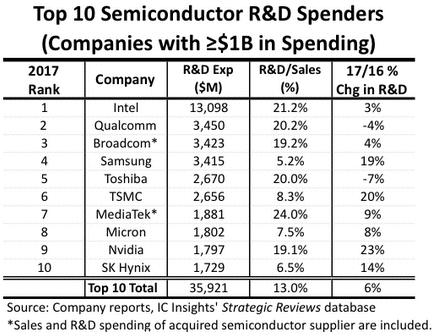Top 10 Semiconductor R&D Spenders Increase Outlays 6% in 2017
Intel far surpasses others with R&D spending of $13.1 billion in 2017 and accounts for 36% of expenditures among Top R&D spenders.
February 19, 2018 -- The ten largest semiconductor R&D spenders increased their collective expenditures to $35.9 billion in 2017, an increase of 6% compared to $34.0 billion in 2016. Intel continued to far exceed all other semiconductor companies with R&D spending that reached $13.1 billion. In addition to representing 21.2% of its semiconductor sales last year, Intel’s R&D spending accounted for 36% of the top 10 R&D spending and about 22% of total worldwide semiconductor R&D expenditures of $58.9 billion in 2017, according to the 2018 edition of The McClean Report that was released in January 2018. Figure 1 shows IC Insights’ ranking of the top semiconductor R&D spenders, including both semiconductor manufacturers and fabless suppliers.

Figure 1
Intel’s R&D expenditures increased just 3% in 2017, below its 8% average annual growth rate since 2001, according to the new report. Still, Intel’s R&D spending exceeded the combined R&D spending of the next four companies—Qualcomm, Broadcom, Samsung, and Toshiba—listed in the ranking.
Underscoring the growing cost of developing new IC technologies, Intel’s R&D-to-sales ratio has climbed significantly over the past 20 years. In 2017, Intel’s R&D spending as a percent of sales was 21.2%, down from an all-time high of 24.0% in 2015. In 2010, the ratio was 16.4%, 14.5% in 2005, 16.0% in 2000, and just 9.3% in 1995.
Qualcomm—the industry’s largest fabless IC supplier—was again ranked as second-largest R&D spender, a position it first achieved in 2012. Qualcomm’s semiconductor-related R&D spending was down 4% in 2017, after a 7% drop in 2016, and it was close to being passed up by third place Broadcom and fourth placed Samsung, whose R&D spending increased 4% and 19%, respectively.
Despite increasing its R&D expenditures by 19% in 2017, Samsung had the lowest investment-intensity level among the top-10 R&D spenders with research and development funding at 5.2% of sales last year. Samsung’s 49% increase in semiconductor revenue in 2017 (driven by strong growth in DRAM and NAND flash memory) lowered its R&D as a percent of sales ratio from 6.5% in 2016. Micron Technology’s revenues surged 77% in 2017, but its research and development expenditures grew 8%, resulting in an R&D/sales ratio of 7.5% compared to 12.5% in 2016. Similarly, SK Hynix’s sales climbed 79% in 2017, while its research and development spending increased 14% in the year, which resulted in an R&D/sakes ratio of 6.5% versus 10.2% in 2016.
Fifth-ranked Toshiba and sixth-ranked Taiwan Semiconductor Manufacturing Co. (TSMC) each allocated about the same amount for R&D spending in 2017. Toshiba’s R&D spending was down 7% while TSMC had one of the largest increases in R&D spending among the top 10 companies shown in the figure. TSMC’s R&D expenditures grew by 20% as the foundry raced rivals Samsung and GlobalFoundries in launching new process technologies, while its sales rose 9% to $32.2 billion in the year.
Rounding out the top-10 list were MediaTek, Micron, Nvidia, which moved from 11th place in 2016 to 9th position to displace NXP in the 2017 ranking, and SK Hynix. Collectively, the top-10 R&D spenders increased their outlays by 6% in 2017, two points more than the 4% R&D increase for the entire semiconductor industry. Combined R&D spending by the top 10 exceeded total spending by the rest of the semiconductor companies ($35.9 billion versus $23.0 billion) in 2017.
A total of 18 semiconductor suppliers allocated more than more than $1.0 billion for R&D spending 2017. The other eight manufacturers were NXP, TI ST, AMD, Renesas, Sony, Analog Devices, and GlobalFoundries.
Report Details: The 2018 McClean Report
Additional details on semiconductor R&D spending and other technology trends within the IC industry are provided in The McClean Report—A Complete Analysis and Forecast of the Integrated Circuit Industry (released in January 2018). A subscription to The McClean Report includes free monthly updates from March through November (including a 250+ page Mid-Year Update), and free access to subscriber-only webinars throughout the year. An individual-user license to the 2018 edition of The McClean Report is priced at $4,290 and includes an Internet access password. A multi-user worldwide corporate license is available for $7,290.
Related Semiconductor IP
- HBM4 PHY IP
- Ultra-Low-Power LPDDR3/LPDDR2/DDR3L Combo Subsystem
- MIPI D-PHY and FPD-Link (LVDS) Combinational Transmitter for TSMC 22nm ULP
- HBM4 Controller IP
- IPSEC AES-256-GCM (Standalone IPsec)
Related News
- TSMC First Pure-Play Foundry to Join Top-10 R&D Spenders
- Top Semiconductor R&D Leaders Ranked for 2014
- Samsung Forecast to Top Intel as the #1 Semiconductor Supplier in 2017
- IFI CLAIMS Announces 2017 Top U.S. Patent Recipients
Latest News
- AI Directs UFS Advancement
- Qualitas Semiconductor Expands Automotive Momentum with 5nm IP Bundle Agreement
- Cyient Semiconductors Acquires Majority Stake in Kinetic Technologies to Drive Custom Power IC Leadership for Edge AI and High-Performance Compute Markets
- Rivian Unveils Custom Silicon, Next-Gen Autonomy Platform, and Deep AI Integration
- NanoXplore raises €20 million from MBDA and Bpifrance to accelerate its diversification into defense and its growth in support of European strategic sovereignty